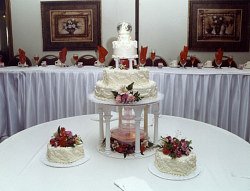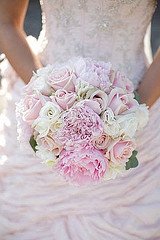Wedding Traditions, Origins and Some Alternative Ideas for Today
The most common wedding traditions that take place during the reception include toasting the bride and groom, the newlyweds' first dance as husband and wife, and the cake cutting.
Toasting. Usually, it is the best man who will give a toast to the newly married couple. The maid of honor can present her toast also. The bride and groom can respond with a toast of their own.One unique thing that we did during our wedding reception was to have my uncle read a letter from my parents who were overseas and were unable to attend our wedding. It was an emotionally charged moment for everyone. After the letter was read, almost everyone was choking back tears.
Its Origin. In early Greece, eliminating enemies with poisoned wine was commonplace. To show that the wine at a party was safe to drink, the host would pour wine from the pitcher and take a drink. Then, he would lift his glass to his guests, indicating that they could drink without fear. The practice is called toasting because the Romans had a practice of dipping toasted bread into poor wines to make them more palatable. Over time, the drink itself became known as a toast.
First dance as husband and wife. The music that you pick for your first dance as a married couple tells a lot about you as a couple. It could be the type of music or it could be the lyrics of the music. For our first dance as husband and wife, we picked a country song When I Said I Do by Clint Black.
We are really not into country music but this song just expresses so much about how we feel for each other.

Wedding Cakes. The origin of this wedding tradition is very interesting. In early Rome and Scotland, wheat buns and oatcakes were crumbled over the bride's and groom's heads to encourage fertility. In the Middle Ages, guests brought small cakes and stacked them on top of one another.
The bride and groom kiss over the top of the stack without knocking over the cakes. If they succeeded, luck and prosperity marked their married life. Over time, the cakes were covered with icing and the tiered wedding cake was born. Feeding each other a bite of cake is symbolic of sharing your lives with each other.
Bouquet toss. This is a very common wedding tradition and some people look for alternatives to this one. One charming alternative is to invite all the couples to dance. The DJ then stops the music and asks everyone who has been married one day or less to sit down. The dancing continues, with the DJ (or bandleader) continuing to stop and ask couples who have been together five years or less, ten years or less, etc., to sit down. When one couple is left on the dance floor, the bride presents her bouquet to the woman and asks the couple to share their secret for a long happy marriage.
Its Origin. Long ago, evil spirits were thought to hang around joyous events like weddings, hoping to steal happiness and cause bad luck. As the bride left the celebration, she tossed one of her shoes over her shoulder. The woman who caught it would be safe from the evil spirits and have good luck finding a husband. Catching the shoe came to mean that the woman could be the next to marry. Over the years, the custom evolved into throwing the bouquet, rather than a shoe. Money Dance. This varies by culture. Some do this by having the bride in the middle of the dance floor and the guests will line up to have a turn dancing with her. Before they can do that though, they have to "pay" for the privilege. The maid of honor wears an apron and "collects" the money from the guests before they can have their turn. Towards the end, the groom will then try to get to the bride and the guests will try their best to prevent that from happening. It can get rowdy but it is fun.
Another variation is to have the bride and groom do a dance in the middle and guests would then pin money on the couple. This is a
When planning what kind of wedding traditions you should embrace for your wedding, how about considering your cultural traditions and customs? This would make for a truly unique and personal wedding celebration.








